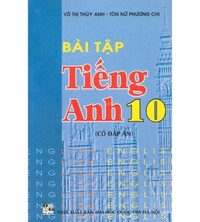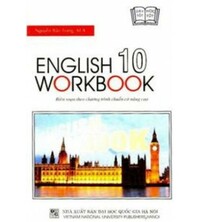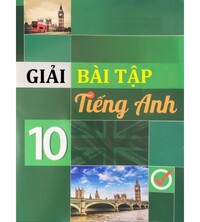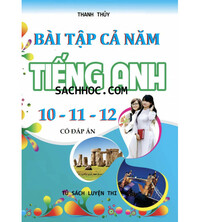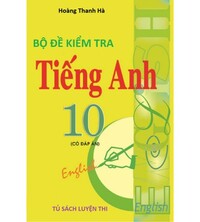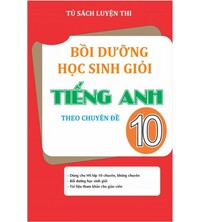Đề thi học kì 2 Tiếng Anh 10 English Discovery - Đề số 2
I. Choose the word whose underlined part is pronounced differently. II. Choose the word that has a different stressed syllable from the rest. III. Choose the best option (A, B, C or D) to complete each of the following sentences. IV. Write the correct forms of the words in brackets. V. Listen and circle the correct choice.
Đề bài
I. Choose the word whose underlined part is pronounced differently.
1.
A. offer
B. worship
C. coffee
D. important
2.
A. corridor
B. science
C. library
D. line
II. Choose the word that has a different stressed syllable from the rest.
3.
A. cotton
B. perfume
C. refund
D. special
4.
A. product
B. except
C. shopping
D. bracelet
III. Choose the best option (A, B, C or D) to complete each of the following sentences.
5. Hoa’s got __________ money to afford herself a car.
A. very few
B. much
C. a lots of
D. very little
6. Since ecotours often take place in remote areas, it is necessary to provide tourists __________ a right travel insurance plan.
A. from
B. for
C. with
D. of
7. The statue of King Ly Thai To is a large sculpture that people put up to __________ the first King of the Ly Dynasty.
A. celebrate
B. miss
C. commemorate
D. remind
8. Students __________ exhaust themselves before the exam don't usually get good grades.
A. who
B. which
C. where
D. why
9. The __________ is where you can buy those gold bracelets.
A. jeweller’s
B. butcher’s
C. optician’s
D. charity shop
10. Cà Mau’s residents __________ a large number of trees to fight erosion.
A. plant
B. build
C. place
D. stock
11. Normally, Mother’s Day __________ on the second Sunday of May, but this year we’re celebrating it early.
A. celebrates
B. holds
C. takes place
D. drops
12. __________ our class finishes, we will line up by the door and move to the gym.
A. Unless
B. When
C. If not
D. Where
13. Yesterday at my birthday party, I __________ a pair of trainers by my best friend – Minh.
A. am given
B. gave
C. was given
D. was being given
14. Việt Nam’s wildlife habitat is home to many __________ creatures, such as leaf-nosed bats, flying squirrels, and Indian elephants.
A. ordinary
B. foreign
C. unnatural
D. exotic
15. In many parts of the world, people teach children to __________ respect to the elderly.
A. pay
B. give
C. offer
D. send
IV. Write the correct forms of the words in brackets.
16. Some people avoid buying no-name __________ because they think the quality isn’t ensured. (PRODUCTION)
17. Many people become so __________ with buying branded clothes. (OBSESSION)
18. This area has largely been __________ due to poor planning. (FOREST)
19. The new policy will be the first scheme to offer __________ against environmental damage. (PROTECT)
20. If I take a gap year, I will be a university _________ next year. (GRADUATION)
V. Listen and circle the correct choice.
21. The Tomatina festival in Spain takes place __________.
A. on the last Wednesday in August
B. on the first Wednesday in August
C. on the last Thursday in August.
22. What do people in the Tomatina festival do before they throw tomatoes?
A. They don’t hurt anyone at the festival.
B. They go to the streets.
C. They crush the tomatoes.
23. Where do the oranges in the Battle of the Oranges come from?
A. The north of Italy.
B. The south of Italy.
C. Outside Italy.
24. Where does the Hokitika festival take place?
A. Spain.
B. Italy.
C. New Zealand.
25. What is wild food in Hokitika festival?
A. food you find outside the city.
B. food in the supermarket.
C. food in the jungle.
VI. Read the text and choose the best option (A, B, C or D) to complete each of the blank below.
I went (26) ________ a trip to Sapa last November and had a great time. However, during the trip, I fell off a motorbike and broke my arm. Some locals took me to a nearby hospital, (27) ________ I was surprised to see a young American woman working. She asked: "How did you hurt your arm?" I told her I (28) ________ the beautiful landscape and rainforest when I fell off my motorbike.
I asked her what she was doing in a hospital in Việt Nam. She was spending a year as a volunteer at a local hospital. She wanted to learn about the village (29) ________, so she came to Việt Nam.
After the doctor helped me, the American volunteer asked me where my hotel was. I told her and she arranged someone (30) ________ me there. She told me to stay off motorbikes for a while.
26.
A. on
B. out
C. for
D. off
27.
A. which
B. where
C. there
D. when
28.
A. admired
B. had admired
C. was admiring
D. used to admire
29.
A. health
B. healthcare
C. wealth
D. lifestyle
30.
A. take
B. taking
C. took
D. to take
VII. Read the passage and and complete the summary below with no more than two words for each blank.
Branding has played a large part in consumer behaviour for many years. Why is wearing someone else’s brand so important to our society, instead of deciding on our own what is good taste and what is not?
First, wearing branded clothes can tell others where we are on the economic scale. There is a certain order in society and wearing branded products tells those we meet that we are in a lower group, the same group or a higher socioeconomic group than they are, depending on the prestige and price of the items worn.
Second, there is, of course, a sense of pride in ownership. Everyone wants to own beautiful and well-made things, and branded products tend to be of high quality. Each time you shut the car door and hear that classic “thud”, it tells you that you have purchased a well-made machine. Every morning when you get up and slip that gold watch over your hand, you take a moment just to appreciate its art.
Finally, branding lets you free from worries. When a man goes shopping for his wife and he knows she likes a certain brand, he doesn’t have to think any further than the brand name. Anything that has that particular name on it will please his wife. Individuals no longer think about what is good design or bad; if it has some well-advertised name on it, it must be good. If there is something wrong with the products, we can easily ask for a refund.
Branded products have played an important part in our society. First, we can tell others where we are on the (31) __________ when we wear branded clothes. This often depends on the prestige and the price of the things we wear. Second, these products can give us a sense of (32) _________ in ownership. This is because branded merchandise is often well-made and of high (33) __________. Finally, branding frees you from (34) __________. For example, when a man wants to give his wife a present, anything with a name on it is likely to please her. In case there is a defect in the product purchased, people can demand a (35) __________
VIII. Use the words in capitals to rewrite the sentences. Do not change the given word.
36. Fairtrade has improved the lives of local farmers.
=> The lives of local farmers ___________________.
37. Mai asked me, ‘Do you want to see a mountain tomorrow?’
=> Mai asked me _____________________________.
38. You don’t look closely the picture. You can’t see a small house and many trees.
=> If _______________________________________.
39. I know a boy. He speaks perfect Chinese. (who)
=> I know a boy ______________________________.
40. Is there a place where we can buy cheaper clothes? (anywhere)
=> Is _______________________________________?
-------------------------THE END-------------------------
Đáp án
HƯỚNG DẪN GIẢI
Thực hiện: Ban chuyên môn

36. The lives of local farmers have been improved by fairtrade.
37. Mai asked me if I wanted to see a mountain the day after.
38. If you looked closely the picture, you could see a small house and many trees.
39. I know a boy who speaks perfect Chinese.
40. Is there anywhere for us to buy cheaper clothes?
HƯỚNG DẪN GIẢI CHI TIẾT
1. B
Kiến thức: Phát âm “o”
Giải thích:
A. offer /ˈɒf.ər/
B. worship /ˈwɜː.ʃɪp/
C. coffee /ˈkɒf.i/
D. important /ɪmˈpɔː.tənt/
Phần được gạch chân ở phương án B được phát âm /ɜː/, các phương án còn lại phát âm /ɒ/.
Chọn B
2. A
Kiến thức: Phát âm “e”
Giải thích:
A. corridor /ˈkɒr.ɪ.dɔːr/
B. science /ˈsaɪ.əns/
C. library /ˈlaɪ.brər.i/
D. line /laɪn/
Phần được gạch chân ở phương án A được phát âm /ɪ/, các phương án còn lại phát âm /aɪ /.
Chọn A
3. B
Kiến thức: Trọng âm
Giải thích:
A. cotton /ˈkɒt.ən/
B. perfume /pɝːˈfjuːm/
C. refund /ˈriː.fʌnd/
D. special /ˈspeʃ.əl/
Phương án B có trọng âm 2, các phương án còn lại có trọng âm 1.
Chọn B
4. B
Kiến thức: Trọng âm
Giải thích:
A. product /ˈprɒd.ʌkt/
B. except /ɪkˈsept/
C. shopping /ˈʃɒp.ɪŋ/
D. bracelet /ˈbreɪ.slət/
Phương án B có trọng âm 2, các phương án còn lại có trọng âm 1.
Chọn B
5. D
Kiến thức: Lượng từ
Giải thích:
A. very few + danh từ đếm được số nhiều (rất ít)
B. much + danh từ không đếm được (nhiều)
C. a lots of => sai
D. very little + danh từ không đếm được (rất ít)
Hoa’s got very little money to afford herself a car.
(Hoa có rất ít tiền để mua cho mình một chiếc ô tô.)
Chọn D
6. C
Kiến thức: Giới từ
Giải thích:
A. from: từ
B. for: cho
C. with : với
D. of: của
Cụm từ “provide sb with sth”: cung cấp cho ai cái gì.
Since ecotours often take place in remote areas, it is necessary to provide tourists with a right travel insurance plan.
(Vì các chuyến du lịch sinh thái thường diễn ra ở những vùng sâu, vùng xa nên việc cung cấp cho khách du lịch một chương trình bảo hiểm du lịch phù hợp là rất cần thiết.)
Chọn C
7. C
Kiến thức: Từ vựng
Giải thích:
A. celebrate (v): ăn mừng
B. miss (v): nhớ
C. commemorate (v): tưởng nhớ
D. remind (v): nhắc nhở
The statue of King Ly Thai To is a large sculpture that people put up to commemorate the first King of the Ly Dynasty.
(Tượng đài vua Lý Thái Tổ là một tác phẩm điêu khắc lớn được người dân dựng lên để tưởng nhớ vị vua đầu tiên của triều đại nhà Lý.)
Chọn C
8. A
Kiến thức: Đại từ quan hệ
Giải thích:
A. who : người mà
B. which: cái mà
C. where: nơi mà
D. why: tại sao
Trước vị trí trống là danh từ chỉ người “students” (những học sinh), phía sau là một động từ “exhaust” (kiệt sức) => dùng “who”
Students who exhaust themselves before the exam don't usually get good grades.
(Học sinh kiệt sức trước kỳ thi thường không đạt điểm cao.)
Chọn A
9. A
Kiến thức: Từ vựng
Giải thích:
A. jeweller’s (n): cửa hàng trang sức
B. butcher’s (n): quầy thịt
C. optician’s (n): tiệm khám mắt
D. charity shop (n): cửa hàng từ thiện
The jeweller’s is where you can buy those gold bracelets.
(Cửa hàng trang sức là nơi bạn có thể mua những chiếc vòng tay bằng vàng đó.)
Chọn A
10. A
Kiến thức: Từ vựng
Giải thích:
A. plant (v): trồng
B. build (v): xây
C. place (v): đặt
D. stock (v): dự trữ
Cà Mau’s residents plant a large number of trees to fight erosion.
(Người dân Cà Mau trồng nhiều cây để chống xói mòn.)
Chọn A
11. C
Kiến thức: Từ vựng
Giải thích:
A. celebrates (v): ăn mừng
B. holds (v): tổ chức
C. takes place (v): diển ra
D. drops (v): rơi
Normally, Mother’s Day takes place on the second Sunday of May, but this year we’re celebrating it early.
(Thông thường, Ngày của Mẹ diễn ra vào Chủ nhật thứ hai của tháng Năm, nhưng năm nay chúng tôi tổ chức sớm hơn.)
Chọn C
12. B
Kiến thức: Từ vựng
Giải thích:
A. Unless: trừ khi
B. When: khi
C. If not: nếu không
D. Where: ở đâu
When our class finishes, we will line up by the door and move to the gym.
(Khi lớp học của chúng tôi kết thúc, chúng tôi sẽ xếp hàng trước cửa và di chuyển đến phòng tập thể dục.)
Chọn B
13. C
Kiến thức: Thể bị động
Giải thích:
Dấu hiệu nhận biết thể bị động “by” (bởi).
Dấu hiệu nhận biết thì quá khứ đơn “yesterday” (hôm qua) => công thức thì quá khứ đơn ở dạng bị động chủ ngữ số ít “I” (tôi): S + was + V3/ed + (by O).
give – gave – given (v): tặng
Yesterday at my birthday party, I was given a pair of trainers by my best friend – Minh.
(Hôm qua trong bữa tiệc sinh nhật của tôi, tôi đã được người bạn thân nhất của tôi – Minh – tặng cho một đôi giày thể thao.)
Chọn C
14. D
Kiến thức: Từ vựng
Giải thích:
A. ordinary (adj): bình thường
B. foreign (adj): nước ngoài
C. unnatural (adj): không tự nhiên
D. exotic (adj): ngoại lai
Việt Nam’s wildlife habitat is home to many exotic creatures, such as leaf-nosed bats, flying squirrels, and Indian elephants.
(Môi trường sống hoang dã của Việt Nam là nơi sinh sống của nhiều sinh vật ngoại lai, chẳng hạn như dơi mũi lá, sóc bay và voi Ấn Độ.)
Chọn D
15. A
Kiến thức: Từ vựng
Giải thích:
A. pay (v): chi trả
B. give (v): đưa
C. offer (v): cung cấp
D. send (v): gửi
Cụm động từ “pay respect to sb”: chào hỏi/ dành sự tôn trọng cho…
In many parts of the world, people teach children to pay respect to the elderly.
(Ở nhiều nơi trên thế giới, người ta dạy trẻ em kính trọng người già.)
Chọn A
16. products
Kiến thức: Từ vựng – Từ loại
Giải thích:
Sau động từ “buy” (mua) cần một danh từ.
production (n): sự sản xuất => product (n): sản phẩm
Dựa vào nghĩa của câu nên cần một danh từ số nhiều.
Some people avoid buying no-name products because they think the quality isn’t ensured.
(Một số người ngại mua hàng không tên tuổi vì cho rằng chất lượng không đảm bảo.)
Đáp án: product
17. obsessed
Kiến thức: Từ vựng – Từ loại
Giải thích:
Sau động từ “become” (trở nên) cần một tính từ.
obsession (n): sự ám ảnh => obsessed (adj): bị ám ảnh
Many people become so obsessed with buying branded clothes.
(Nhiều người trở nên quá ám ảnh với việc mua quần áo hàng hiệu.)
Đáp án: obsessed
18. reforested
Kiến thức: Từ vựng – Từ loại
Giải thích:
Sau động từ tobe “been” cần một động từ ở dạng V3/ed để tạo nên câu bị động.
forest (n): rừng => deforest (v): tàn phá rừng
deforest – deforested – deforested (v): tàn phá rừng
This area has largely been deforested due to poor planning.
(Khu vực này phần lớn đã tàn phá rừng trên diện rộng do quy hoạch kém.)
Đáp án: reforested
19. protection
Kiến thức: Từ vựng – Từ loại
Giải thích:
Sau động từ “offer” (cung cấp) cần một danh từ.
protect (v): bảo vệ => protection (n): sự bảo vệ
The new policy will be the first scheme to offer protection against environmental damage.
(Chính sách mới sẽ là kế hoạch đầu tiên cung cấp sự bảo vệ chống lại thiệt hại về môi trường.)
Đáp án: protection
20. graduate
Kiến thức: Từ vựng – Từ loại
Giải thích:
Sau mạo từ “a” cần một cụm danh từ.
graduation (n): sự tốt nghiệp => graduate (n): người tốt nghiệp
If I take a gap year, I will be a university graduate next year.
(Nếu tôi nghỉ một năm, tôi sẽ tốt nghiệp đại học vào năm sau.)
Đáp án: graduate
21. A
Kiến thức: Nghe hiểu
Giải thích:
Lễ hội Tomatina ở Tây Ban Nha diễn ra __________.
A. vào ngày thứ Tư cuối cùng của tháng 8
B. vào ngày thứ tư đầu tiên của tháng tám
C. vào ngày thứ Năm cuối cùng của tháng Tám.
Thông tin: The festival takes place every August in Bunol – on the last Wednesday in August.
(Lễ hội diễn ra vào tháng 8 hàng năm tại Bunol - vào thứ Tư cuối cùng của tháng 8.)
Chọn A
22. C
Kiến thức: Nghe hiểu
Giải thích:
Mọi người trong lễ hội Tomatina làm gì trước khi ném cà chua?
A. Họ không làm hại ai tại lễ hội.
B. Họ xuống đường.
C. Họ nghiền cà chua.
Thông tin: They crush the tomatoes first, so they don’t hurt anyone.
(Họ nghiền nát cà chua trước để không làm đau ai.)
Chọn C
23. B
Kiến thức: Nghe hiểu
Giải thích:
Những quả cam trong Battle of the Oranges đến từ đâu?
A. Miền bắc nước Ý.
B. Miền nam nước Ý
C. Bên ngoài nước Ý
Thông tin: This is a food festival. It takes place every year in Ivrea, which is in the north of Italy.
(Đây là một lễ hội ẩm thực. Nó diễn ra hàng năm ở Ivrea, phía bắc nước Ý.)
Chọn B
24. C
Kiến thức: Nghe hiểu
Giải thích:
Lễ hội Hokitika diễn ra ở đâu?
A. Tây Ban Nha.
B. Ý.
C. New Zealand
Thông tin: And the last food festival that I want to introduce is the Hokitika. This is a festival in New Zealand.
(Và lễ hội ẩm thực cuối cùng mà tôi muốn giới thiệu chính là Hokitika. Đây là một lễ hội ở New Zealand.)
Chọn C
25. A
Kiến thức: Nghe hiểu
Giải thích:
Thức ăn hoang dã trong lễ hội Hokitika là gì?
A. thực phẩm bạn tìm thấy bên ngoài thành phố.
B. thực phẩm trong siêu thị.
C. thức ăn trong rừng.
Thông tin: The festival is about wild food – food you find in the countryside. You can’t buy wild food in the supermarket.
(Lễ hội nói về thức ăn hoang dã – thức ăn bạn tìm thấy ở vùng nông thôn. Bạn không thể mua thức ăn hoang dã trong siêu thị.)
Chọn A
Bài nghe:
Today we’re going to learn about three different food festivals in the world.
Starting with the Tomatina. This is a festival in Spain. The festival takes place every August in Bunol – on the last Wednesday in August. Thousands of people go to the festival every year. At the Tomatina, people go to the main square, and they throw tomatoes. It’s very messy but lots of fun!
Moving on to the Battle of the Oranges. This is a food festival. It takes place every year in Ivrea, which is in the north of Italy. At the festival, nine teams of people throw oranges. Thousands of people take part. The oranges are not from Ivrea – they are from the south of Italy. Each year, people throw about 265,000 kilos of oranges in total.
And the last food festival that I want to introduce is the Hokitika. This is a festival in New Zealand. It happens every year in March. The festival is about wild food – food you find in the countryside. You can’t buy wild food in the supermarket. At the festival, you can try different kinds of wild food, for example, crocodile. It’s a popular festival and thousands of people attend!
Tạm dịch:
Hôm nay chúng ta sẽ tìm hiểu về ba lễ hội ẩm thực khác nhau trên thế giới.
Bắt đầu với Tomatina. Đây là một lễ hội ở Tây Ban Nha. Lễ hội diễn ra vào tháng 8 hàng năm tại Bunol - vào thứ Tư cuối cùng của tháng 8. Hàng ngàn người đi đến lễ hội mỗi năm. Tại Tomatina, mọi người đến quảng trường chính và ném cà chua. Nó rất lộn xộn nhưng rất thú vị!
Chuyển sang Trận chiến của những quả cam. Đây là một lễ hội ẩm thực. Nó diễn ra hàng năm ở Ivrea, phía bắc nước Ý. Tại lễ hội, chín đội ném cam. Hàng ngàn người tham gia. Những quả cam không phải từ Ivrea - chúng đến từ miền nam nước Ý. Mỗi năm, người ta ném tổng cộng khoảng 265.000 kg cam.
Và lễ hội ẩm thực cuối cùng mà tôi muốn giới thiệu chính là Hokitika. Đây là một lễ hội ở New Zealand. Nó xảy ra hàng năm vào tháng Ba. Lễ hội nói về thức ăn hoang dã – thức ăn bạn tìm thấy ở vùng nông thôn. Bạn không thể mua thức ăn hoang dã trong siêu thị. Tại lễ hội, bạn có thể thử các loại thức ăn hoang dã khác nhau, chẳng hạn như cá sấu. Đó là một lễ hội nổi tiếng và hàng ngàn người tham dự!
26. A
Kiến thức: Giới từ
Giải thích:
A. on: trên
B. out: ngoài
C. for: cho
D. off: tắt
Cụm động từ “go on a trip”: có một chuyến đi
I went on a trip to Sapa last November and had a great time.
(Tôi đã đi du lịch Sapa vào tháng 11 năm ngoái và đã có một khoảng thời gian tuyệt vời.)
Chọn A
27. B
Kiến thức: Trạng từ quan hệ
Giải thích:
Phía trước vị trí trống là trạng ngữ chỉ nơi chốn “nearby hospital” (bệnh viện gần đó), phía sau là mệnh đề S + V => dùng “where”
Some locals took me to a nearby hospital, where I was surprised to see a young American woman working.
(Một số người dân địa phương đưa tôi đến một bệnh viện gần đó, nơi tôi ngạc nhiên khi thấy một phụ nữ trẻ người Mỹ đang làm việc.)
Chọn B
28. C
Kiến thức: Thì quá khứ tiếp diễn
Giải thích:
Hai hành động xảy ra trong quá khứ nối với nhau bằng “when” (khi) diễn tả hành động này cắt hành động kia có công thức: S + was / were + Ving + when + S + V2/ed.
admire (v): chiêm ngưỡng
I told her I was admiring the beautiful landscape and rainforest when I fell off my motorbike.
(Tôi nói với cô ấy rằng tôi đang chiêm ngưỡng phong cảnh tuyệt đẹp và khu rừng nhiệt đới thì tôi bị ngã khỏi xe máy.)
Chọn C
29. B
Kiến thức: Từ vựng
Giải thích:
A. health (n): sức khỏe
B. healthcare (n): chăm sóc sức khỏe
C. wealth (n): sự giàu có
D. lifestyle (n): lối sống
She wanted to learn about the village healthcare, so she came to Việt Nam.
(Cô ấy muốn tìm hiểu về chăm sóc sức khỏe của làng quê, vì vậy cô ấy đã đến Việt Nam.)
Chọn B
30. D
Kiến thức: Dạng động từ
Giải thích:
Sau động từ “arrange” (sắp xếp) cần một động từ theo sau ở dạng “to V”.
take (v): dẫn
I told her and she arranged someone to take me there.
(Tôi nói với cô ấy và cô ấy sắp xếp người đưa tôi đến đó.)
Chọn D
Bài đọc hoàn chỉnh:
I went (26) on a trip to Sapa last November and had a great time. However, during the trip, I fell off a motorbike and broke my arm. Some locals took me to a nearby hospital, (27) where I was surprised to see a young American woman working. She asked: "How did you hurt your arm?" I told her I (28) was admiring the beautiful landscape and rainforest when I fell off my motorbike.
I asked her what she was doing in a hospital in Việt Nam. She was spending a year as a volunteer at a local hospital. She wanted to learn about the village (29) healthcare, so she came to Việt Nam.
After the doctor helped me, the American volunteer asked me where my hotel was. I told her and she arranged someone (30) to take me there. She told me to stay off motorbikes for a while.
Tạm dịch:
Tôi đã (26) đi một chuyến đi đến Sapa vào tháng 11 năm ngoái và đã có một khoảng thời gian tuyệt vời. Tuy nhiên, trong chuyến đi, tôi bị ngã xe máy và bị gãy tay. Một số người dân địa phương đưa tôi đến một bệnh viện gần đó, (27) nơi tôi ngạc nhiên khi thấy một phụ nữ trẻ người Mỹ đang làm việc. Cô ấy hỏi: "Làm thế nào bạn làm tổn thương cánh tay của bạn?" Tôi nói với cô ấy rằng tôi (28) đang chiêm ngưỡng phong cảnh tuyệt đẹp và khu rừng nhiệt đới thì bị ngã xe máy.
Tôi hỏi cô ấy đang làm gì trong một bệnh viện ở Việt Nam. Cô đã dành một năm làm tình nguyện viên tại một bệnh viện địa phương. Cô ấy muốn tìm hiểu về làng (29) chăm sóc sức khỏe, vì vậy cô ấy đã đến Việt Nam.
Sau khi bác sĩ giúp tôi, tình nguyện viên người Mỹ hỏi tôi khách sạn của tôi ở đâu. Tôi nói với cô ấy và cô ấy đã sắp xếp một người nào đó (30) để đưa tôi đến đó. Cô ấy bảo tôi tránh xa xe máy một thời gian.
31. economic scale
Kiến thức: Đọc hiểu
Giải thích:
Sau mạo từ “the” cần một cụm danh từ.
economic scale (n): quy mô kinh tế
First, we can tell others where we are on the economic scale mwhen we wear branded clothes.
(Đầu tiên, chúng ta có thể cho người khác biết chúng ta đang ở đâu trên quy mô kinh tế khi chúng ta mặc quần áo hàng hiệu.)
Thông tin: First, wearing branded clothes can tell others where we are on the economic scale.
(Đầu tiên, mặc quần áo hàng hiệu có thể cho người khác biết chúng ta đang ở đâu trên quy mô kinh tế.)
Đáp án: economic scale
32. pride
Kiến thức: Đọc hiểu
Giải thích:
Sau giới từ “of” cần một danh từ.
pride (n): niềm tự hào
Second, these products can give us a sense of pride in ownership.
(Thứ hai, những sản phẩm này có thể mang lại cho chúng ta cảm giác tự hào về quyền sở hữu.)
Thông tin: Second, there is, of course, a sense of pride in ownership.
(Thứ hai, tất nhiên, có một cảm giác tự hào về quyền sở hữu.)
Đáp án: pride
33. quality
Kiến thức: Đọc hiểu
Giải thích:
- Sau tính từ “high” (cao) cần một danh từ.
quality (n): chất lượng
This is because branded merchandise is often well-made and of high quality.
(Điều này là do hàng hóa có thương hiệu thường được sản xuất tốt và có chất lượng cao.)
Thông tin: Everyone wants to own beautiful and well-made things, and branded products tend to be of high quality.
(Mọi người đều muốn sở hữu những thứ đẹp đẽ và được làm tốt, và các sản phẩm có thương hiệu thường có chất lượng cao.)
Đáp án: quality
34. worries
Kiến thức: Đọc hiểu
Giải thích:
Sau giới từ “from” cần một danh từ.
worries (n): những nỗi lo
Finally, branding frees you from worries.
(Cuối cùng, xây dựng thương hiệu giải phóng bạn khỏi những lo lắng.)
Thông tin: Finally, branding lets you free from worries.
(Cuối cùng, xây dựng thương hiệu giúp bạn không phải lo lắng.)
Đáp án: worries
35. refund
Kiến thức: Đọc hiểu
Giải thích:
Sau mạo từ “a” cần một danh từ đếm được số ít.
refund (n): tiền hoàn trả
In case there is a defect in the product purchased, people can demand a refund.
(Trong trường hợp có lỗi trong sản phẩm đã mua, mọi người có thể yêu cầu hoàn lại tiền.)
Thông tin: If there is something wrong with the products, we can easily ask for a refund.
(Nếu có vấn đề gì với sản phẩm, chúng tôi có thể dễ dàng yêu cầu hoàn lại tiền.)
Đáp án: refund
36.
Kiến thức: Câu bị động
Giải thích:
Cấu trúc câu chủ động của thì hiện tại hoàn thành: S + have/ has + V3/ed.
Cấu trúc câu bị động của thì hiện tại hoàn thành với chủ ngữ số nhiều “the lives” (cuộc sống): S + have been + V3/ed + (by O).
improve – improved – improved (v): cải thiện
Fairtrade has improved the lives of local farmers.
(Hội chợ thương mại đã cải thiện cuộc sống của nông dân địa phương.)
Đáp án: The lives of local farmers have been improved by fairtrade.
(Cuộc sống của nông dân địa phương đã được cải thiện nhờ hội chợ thương mại.)
37.
Kiến thức: Câu tường thuật
Giải thích:
Cấu trúc câu tường thuật dạng câu hỏi Yes/No với động từ tường thuật “asked” (hỏi): S + asked + O + if + S + V (lùi thì).
Quy tắc lùi thì: thì hiện tại “want” => thì quá khứ đơn “wanted” (muốn)
Quy tắc đổi trạng ngữ chỉ thời gian: “tomorrow” => the day after” (ngày mai)
Mai asked me, ‘Do you want to see a mountain tomorrow?’
(Mai hỏi tôi, 'Ngày mai bạn có muốn đi xem núi không?')
Đáp án: Mai asked me if I wanted to see a mountain the day after.
(Mai hỏi tôi có muốn đi xem núi vào ngày hôm sau không.)
38.
Kiến thức: Câu điều kiện loại 2
Giải thích:
Câu điều kiện loại 2 diễn tả một việc không có thật ở hiện tại.
Cấu trúc câu điều kiện loại 2: If + S + V2/ed, S + would/ could + Vo (nguyên thể).
look – looked – looked (v): nhìn
You don’t look closely the picture. You can’t see a small house and many trees.
(Bạn không nhìn kỹ bức tranh. Bạn không thể nhìn thấy một ngôi nhà nhỏ và nhiều cây cối.)
Đáp án: If you looked closely the picture, you could see a small house and many trees.
(Nếu bạn nhìn kỹ bức tranh, bạn có thể thấy một ngôi nhà nhỏ và nhiều cây cối.)
39.
Kiến thức: Mệnh đề quan hệ
Giải thích:
Chủ ngữ “he” (anh ấy) ở câu thứ hai thay thế cho danh từ chỉ người “the boy” (cậu bé trai) ở câu đầu tiên => dùng “who”
I know a boy. He speaks perfect Chinese.
(Tôi biết một cậu bé. Anh ấy nói tiếng Trung Quốc hoàn hảo.)
Đáp án: I know a boy who speaks perfect Chinese.
(Tôi biết một cậu bé người mà nói tiếng Trung hoàn hảo.)
40.
Kiến thức: Từ đồng nghĩa
Giải thích:
- anywhere: bất kì nơi nào => dùng cho câu hỏi và câu phủ định
Cấu trúc viết câu hỏi với “anywhere”: Is there + anywhere + for + O + to V?
Is there a place where we can buy cheaper clothes?
(Có nơi nào chúng ta có thể mua quần áo rẻ hơn không?)
Đáp án: Is there anywhere for us to buy cheaper clothes?
(Có nơi nào để chúng ta mua quần áo rẻ hơn không?)
Search google: "từ khóa + timdapan.com" Ví dụ: "Đề thi học kì 2 Tiếng Anh 10 English Discovery - Đề số 2 timdapan.com"
